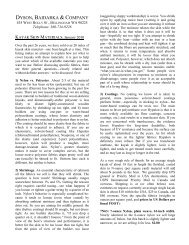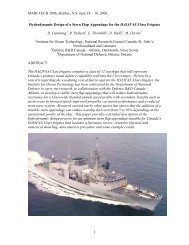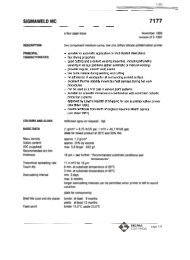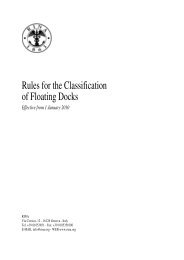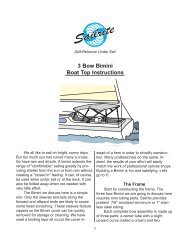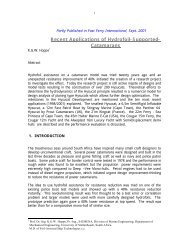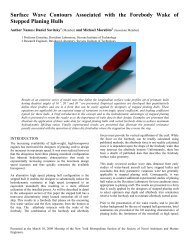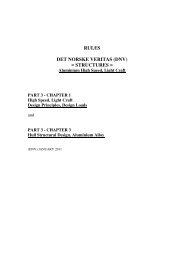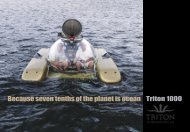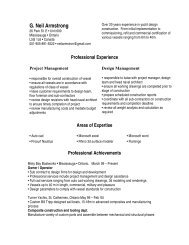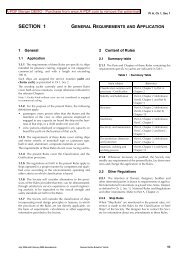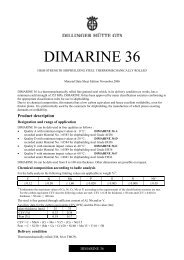CD03 - Issue #74: Designer / Builder Paul Bieker--Process Control ...
CD03 - Issue #74: Designer / Builder Paul Bieker--Process Control ...
CD03 - Issue #74: Designer / Builder Paul Bieker--Process Control ...
Create successful ePaper yourself
Turn your PDF publications into a flip-book with our unique Google optimized e-Paper software.
<strong>Paul</strong> <strong>Bieker</strong> preps his own International 14—a B-3 named Pell Mell—prior to a race.The boat features telescoping racks, a compression vang, and nonferrous rigging.Its deck was made with flat stock, the centerline radius formed with epoxy-filledsaw kerfs on the inside. His shop is called <strong>Bieker</strong> Boats; the design office,Rip Tide Design.swept 1st through 3rd. A year and a halflater they captured eight of the first tenplaces. And in 2001, his boats capturedgold and bronze.Like Bermuda fitted dinghies,International 14s evolved from harbortenders. When 14s became a nationalclass in England in the early 1900s, theyweighed about 250 lbs (113.4 kg). Twocrew hiked out to keep 175 sq ft (16.3sq m) of sail upright. The class wentinternational in the 1920s. Today, 14s flyupwards of 210 sq ft (19.5 sq m) upwindand weigh about 170 lbs (77.1 kg), butthey also fly spinnakers exceeding 500sq ft (46.4 sq m), set on long bowsprits.Their crews develop enormous rightingmoment by hanging on trapezeswhile standing on racks cantilevered offthe boats' sides. Today, a hull mightweigh only 135 lbs (61.2 kg) and themast as little as 15 lbs (6.8 kg). <strong>Bieker</strong>helped propel 14s literally into the jetage thanks to Boeing Corporation'snearby surplus-sales warehouse, whichsupplied him with glass-and-carbonskinnedhoneycomb panels that costless than lumber-yard plywood.Like all designers. <strong>Bieker</strong> says he was"looking for a silver bullet" when hedesigned the <strong>Bieker</strong> 1 comparativelyearly in his career. "My hull shape wasfine-ended with a prismatic coefficient[Cp—the ratio of the boat's volume in itsends to that amidships; a high Cp hasfull ends, a low Cp fine ends] of about0.56 for light-to-moderate air speed. Iwanted straight waterlines forward forupwind speed and a flat run aft fordownwind speed." He discovered,though, that with those constraints, abalanced section-area curve requiredmore rocker forward to balance thestraight waterlines, and very curvedwaterlines aft to balance the straightrun. "The boats were untouchable inlight airs," says <strong>Bieker</strong>. "Crews couldpress the fine entries down to lift thetransoms and reduce drag, but in heavierairs, the boats were definitely touchable.As long as you sailed them flat,they were quite fast, but as soon as theytipped a bit and immersed their curvedsides, or stuffed the highly rockeredforebody into the back of a wave, theybecame very squirrely. That was a greatlesson. A lot of people think that theycan capture an ideal if they just push allof the perceived performance-producingcharacteristics as far as they will go. Butthere are often a lot of unseen tradeoffs."If you think traditional hydrostaticmeasures are irrelevant to boats that areusually pictured flying free of the sea,<strong>Bieker</strong> counters, "Those are photos.Fourteens are actually fairly heavy whenyou put two 180-pound [81.6 kg] guysinto them. You get a displacement-tolengthratio exceeding 100, which is likea keelboat. Or at least, a West Coastkeelboat. Also, in few places in theworld will you race completely in heavyair. To win a Worlds you can't afford anAchilles heel. There's immense powerin not having a weak spot as opposedto having one very strong spot. No matterhow good you are, if your boat is adog in light airs, you're going to pickup a score of 20 or 30 at best on a lightairday, and that's the end of yourseries." Traditional hydrostatic referencesremain "totally critical" to <strong>Bieker</strong>,who also keeps a keen eye on wettedsurface. "One thing I learned from 14sis that the section-of-area curve rules.especially in medium conditions. Olderarchitects would harp: 'It's all in yoursection-area curves.' I thought, of allboats, the 14s might not be governed bythat, but they still are." Because the C pis an average between the forebody andafterbody prismatics, only the sectionareacurve reveals the balance of volumes,and <strong>Bieker</strong> favors one just slightlyhollowed forward.<strong>Bieker</strong> explains how he transformstraditional hydrostatics into moredynamic models: "Crews can trim a 14 alot. In light air they trim bow down, so Ilook at my light-air prismatic with bowclown, as well as level [a C p of about0.6], and heeled. In the 14s, prismaticshave been creeping up, primarily forthe upwind condition, but there aresome tricks you can use to get a higherC p when you want it and lower whenyou want it, and to make your hullshape hard or easy to sail downwind,even when planing. No matter what youdo, though, a low-prismatic boat isgoing to be a bear downwind."For the <strong>Bieker</strong> 2 and 3 designs, <strong>Paul</strong>employed shapes that "were as fair as Icould make them to meet the sectionareacurve and rocker that I wanted."He believes that a center of buoyancy(and gravity) just a few percent aft ofamidships facilitates handling, whichleads to forward sections more V-shaped and deeper than many competitors',though quite similar to designsdating back to Uffa Fox, England's preeminentsmall-craft designer of the lastcentury. <strong>Bieker</strong> believes the deeper forwardsections create smaller bow wavesand slam less upwind, though he iscareful to employ a well-roundedknuckle between the stem and bottomto eliminate any rudder effect from asharp, deep forefoot.The <strong>Bieker</strong> 2 was the first 14 withracks. Maximizing stability had longfavored increased beam forward wherethe crew hikes out, but <strong>Bieker</strong> wanted afiner bow in the topsides, so he decidedto "decouple" the hull shape and forwardcrew's support. The obviouschoices were wings, or racks, as foundon International Moths or SydneyHarbor 18s, respectively. "Some peopleobjected to the racks," says <strong>Bieker</strong>."One rule says that the gunwale has tobe a fair and continuous curve, but theracks aren't gunwales, so it was astretch to make them illegal." For the<strong>Bieker</strong> 3. he went a step further: "Thebottom in the water is roughly the70 PROFESSIONAL BOATBUILDER



